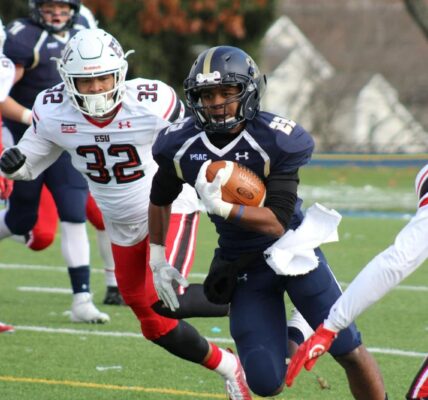In the realm of baseball, the term “bot” serves as a convenient abbreviation for “bottom,” specifically alluding to the latter portion of an inning when the home team assumes their offensive stance at bat. Join us as we embark on a deeper exploration of the distinctive lexicon within baseball while uncovering the strategic intricacies that unfurl during the bottom half of an inning.
Within the realm of baseball, “bot” functions as a concise shorthand for elucidating the ongoing status of an inning. A typical baseball contest comprises nine innings, each of which is bifurcated into two segments: the top and the bottom. Given the brevity of the term “top,” it necessitates no abbreviation. Conversely, the term “bottom” being more extensive, led to the adoption of the acronym “bot” as a succinct means to denote the concluding phase of an inning.
Applications dedicated to scoring, accessible across various technological platforms, frequently employ such abbreviations. These guides prove invaluable in navigating through the complexities of Major League Baseball games.
Diving Deeper: The Meaning of “Bot” in Baseball
In the world of baseball, “Bot” is a commonly used shorthand that signals a distinct segment of the game. It denotes the latter part of an inning, a key concept for newcomers to grasp in order to follow the game’s progression effectively. An inning in baseball is split into two halves: the ‘top’ and the ‘bottom.’ This division is essential for a comprehensive understanding of the game’s structure.
The usage of ‘Bot’ is widespread in baseball culture, transcending beyond just the players and coaches. It’s a term that is frequently employed by commentators, sports journalists, and enthusiastic fans alike. To provide a deeper insight, here is an elaborate explanation:
- The Inning Structure: An inning consists of two halves – the top and the bottom. The ‘top’ of an inning sees the away team at bat, whereas during the ‘bottom’ half, the home team takes its turn to bat;
- Why ‘Bot’ Matters: Besides dictating which team is batting, understanding when the game is in the ‘bot’ is critical to comprehend the game’s strategic aspects. Since the home team always hits at the bottom, they have the final opportunity to score in each inning, allowing for potential come-from-behind wins;
- Where You’ll Encounter ‘Bot’: This abbreviation is commonly used across various platforms. It’s found in live score applications, on gigantic scoreboards at stadiums, or within the pages of the official scorebook. It’s part of the universal code in baseball, allowing fans worldwide to keep track of their favorite teams’ progress.
In conclusion, the term ‘Bot’ in baseball is a key component of the game’s unique language. As you delve deeper into the world of baseball, unravelling these terms can enhance your viewing experience and make you appreciate the game’s intricacies on a different level.
The Inning Structure in Baseball: Understanding the ‘Top’ and ‘Bottom’
In every baseball game, each inning is distinctly divided into two parts – the ‘top’ and the ‘bottom’. The top half initiates the action, with the visiting team stepping up to bat first.
Here are some key components of each inning:
- Game Start: The visiting or away team always gets the first swing at the bat during the ‘top’ half of every inning. It’s a longstanding baseball rule designed to give the home team a minor strategic edge;
- Home Team Advantage: During the ‘bottom’ half of every inning, the home team gets its chance to bat. Having the final batting opportunity in each inning allows the home team to respond to the away team’s scoring efforts.
However, there is a unique exception that can cut short an inning:
- The Ninth Inning Exception: If, after the top of the ninth inning, the home team holds the lead, there’s no need for them to bat in the bottom half. The game ends there, with the home team claiming victory. This condition happens because the away team has no innings left to overturn the result. In essence, all professional games, including those in the Major League Baseball (MLB), play out at least 17 half-innings. If the game heads to the bottom of the ninth inning or extends into extras, the half-innings will increase accordingly.
This rhythm of play, shifting between the ‘top’ and ‘bottom’ throughout innings, sets the pulse of a baseball game. Understanding this mechanism can help you to navigate the scoring patterns, predict team strategies, and better appreciate the finer points of the sport.
Yes! The Home Team Hits During the ‘Bottom’ of Every Inning
In baseball, one of the sport’s most fundamental rules states that the home team is always scheduled to bat during the ‘bottom’ of every inning. This structural detail provides a clear roadmap for an exciting face-off between two competing teams.
In general, the away team kick-starts the action by hitting during the ‘top’ of the inning. Here’s how the standard procedure unfolds:
- The First Hit: As per the traditional rules, the visiting team is always the first to hit, setting the pace for the game;
- The Home Team’s Turn: Once the visiting team finishes its chance at bat, the home team steps up during the ‘bottom’ half of the inning. This pattern is repeated until the game reaches its conclusion.
However, there exists a unique circumstance that presents an exception to this rule:
- Neutral Field Games: Occasionally, teams may play in a neutral location, neither team’s home field. This scenario often occurs during tournament settings. Even in such cases, teams are still designated as ‘home’ and ‘away’ based on a pre-decided arrangement or through random methods such as a coin toss. Regardless of the location, the designated home team will always bat during the bottom half of each inning.
So, in essence, whether it’s a routine local league match or a high-stakes tournament game on a neutral field, the home team maintains its privilege of batting during the bottom half of every inning. This rule creates a unique strategic opportunity for the designated home team to potentially clinify a victory in the game’s final moments. With a good strategy and a bit of luck, the home team could use this advantage to stage a come-from-behind victory or consolidate an already dominant position. Also, unlock the mystery of GIDP in baseball! Explore what does GIDP mean in baseball and how it impacts the game. Dive into the diamond now!
Understanding the Duration of a Baseball Inning’s Bottom Half
In baseball, the duration of the bottom half of an inning, often abbreviated as “bot,” plays a crucial role in the game’s structure. This phase continues until the home team accumulates three outs. Here’s an expanded look at the intricacies and significance of this:
- Mechanics of an Inning: Each inning in baseball is divided into two halves: the top and the bottom. The home team always bats during the bottom half. This half is concluded once the batting team receives three outs, either through strikeouts, fielding plays, or other means;
- Role of Outs in Game Progression: The concept of outs is central to advancing the game. Once three outs are made, the inning progresses to the next half or, if it’s the bottom of the ninth, potentially the end of the game;
- Strategic Implications: Teams often strategize around this structure, aiming to score as many runs as possible before achieving the three-out limit;
- Comparison with the Top Half: Interestingly, both the top and bottom halves of an inning are identical in terms of the number of outs required to end them. However, the home team’s opportunity to bat last can provide a strategic advantage.
Exploring the Significance of the “Bot 9th” in Baseball
The “Bot 9th” in baseball, often referred to as the bottom of the ninth inning, is a pivotal and nail-biting phase of the game that keeps fans on the edge of their seats. Let’s delve deeper into its significance and why it’s a game-changer:

- Last Regular Inning:
- The ninth inning traditionally signals the conclusion of a standard baseball game;
- However, if the score remains tied at this juncture, extra innings may be in store, extending the suspense and excitement.
- Home Team Advantage:
- One of the unique aspects of the ninth inning is that if the home team is ahead after the top of the ninth, they won’t have to bat in the bottom half;
- This strategic advantage underscores the importance of having the final say in a game.
- Consistency Across Innings;
- To maintain uniformity and clarity, the abbreviation “bot” is consistently used to denote the bottom half of each inning;
- For example, “bot 6th” signifies the bottom of the sixth inning, ensuring a consistent language for baseball enthusiasts.
- Impact on Game Outcome:
- The bottom of the ninth inning can be incredibly dramatic, with the potential for game-winning or tying runs;
- This electrifying scenario makes it a highly anticipated moment for both fans and players, often deciding the fate of the game in thrilling fashion.
Understanding the Total Count of Baseball Bots in a Game
In the realm of Major League Baseball (MLB), the number of bottom halves, or “bots,” varies depending on the game’s unfolding dynamics. Here’s a comprehensive breakdown:
- Minimum Number:
- In every MLB game, you can expect a minimum of eight bottom halves. This scenario arises when the home team maintains a lead after the top of the ninth inning, rendering the bottom half unnecessary;
- This minimum count ensures that games with clear leaders conclude promptly.
- Maximum Occurrences:
- The ninth bottom half comes into play when the game is tied after the top of the ninth inning;
- Additionally, if the visiting team seizes the lead in the ninth inning, it gives the home team a final opportunity to bat in the bottom half;
- These situations not only add to the suspense but also showcase the dynamic nature of baseball.
- Inning Structure:
- Baseball’s inning structure is a model of consistency, featuring a bottom half in each inning;
- This consistent framework makes it easy for both players and spectators to follow the game’s progression and stay engaged.
- Impact on Game Length:
- The number of bottom halves directly influences the overall length of a baseball game;
- With the potential for extra innings, the game’s duration can vary significantly, contributing to the unpredictability and excitement that define the sport.
Conclusion
In conclusion, the world of baseball showcases a rich tapestry of terminology and strategic nuances. The abbreviation “bot,” used to represent the bottom half of an inning, exemplifies the sport’s penchant for succinct and efficient communication. As fans and enthusiasts, understanding these intricacies enhances our appreciation for the game, especially when following it through modern scoring apps and guides. So, whether you’re watching a game in person or remotely, the knowledge of “bot” and other baseball jargon adds a layer of enjoyment to this timeless pastime.




